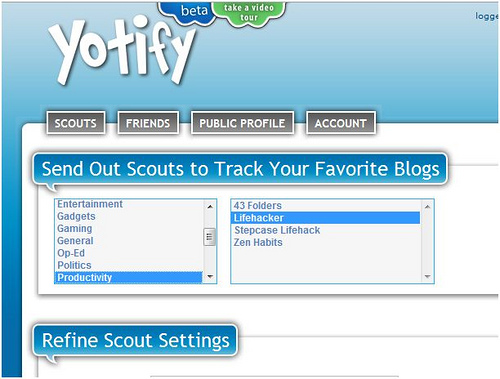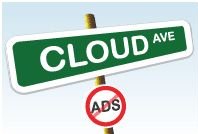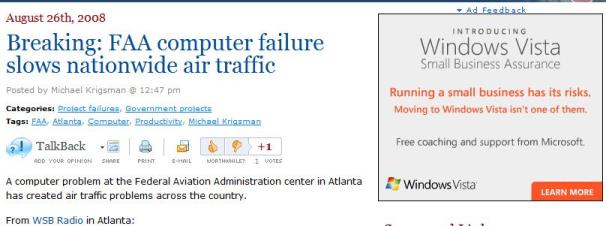Reading that TechCrunch calls Yotify “Google Alerts on Steroids” I had great expectations… that did not last long. For now, it’s a no-go… read my quick review on CloudAve.

Connecting the dots ...

Reading that TechCrunch calls Yotify “Google Alerts on Steroids” I had great expectations… that did not last long. For now, it’s a no-go… read my quick review on CloudAve.


Are we heading into Recession? The “Big R” talk of early this year quickly subsided, economic growth returned, the markets appeared to vindicate the optimists. US Presidential Candidate John McCain repeatedly said the economy was fundamentally strong… until just days ago, when he quickly switched to declaring a crisis. The Wall Street Journal says we’re in the Worst Crisis Since ’30s, With No End Yet in Sight.
 I don’t claim to be an expert economist, so whether the Big R is looming is not my call – but if you believe we’re in a strong economy, I have a bridge to sell you. Let’s just focus this discussion on how Software businesses can survive in a financial crisis, which is undeniably here.
I don’t claim to be an expert economist, so whether the Big R is looming is not my call – but if you believe we’re in a strong economy, I have a bridge to sell you. Let’s just focus this discussion on how Software businesses can survive in a financial crisis, which is undeniably here.
Not all will survive, and it’s probably healthy they won’t. Tim O’Reilly, Father-of-all-things-Web-2.0, asked the question at the Web 2.0 Expo last week:
Global warming. The U.S. losing its edge in science and technology. A growing income gap. “And what are the best and the brightest working on?” O’Reilly asked, displaying a slide of the popular Facebook application SuperPoke, which invites you to, among other things, “throw sheep” at your friends.
“Do you see a problem here?” he posed, showing another slide of the popular iPhone app “iBeer,” which simulates chugging a pint. “You have to ask yourself, are we working on the right things?”
The poster-child of the Web 2.0 boom may very well become the symbol of what went wrong:
Actually, the problem is not what they do, but how seriously they were taken. Will Price, a very smart VC said long ago:
It may well be that Slide raising $55m from mutual fund companies at $500m+ pre-money will be the “what were we thinking” moment of the current cycle.
I’m glad they did not go public, at least not a lot of people will get hurt holding the bag. But enough of what’s wrong, here’s what works:
The last point brings up the price issue. Credit will dry up. Whether we’ll officially declare Recession or not, the fear of the Big R is enough for corporate budget cuts, the disappearance of any CAPEX spending. Even worse, an entire sector almost disappeared as IT buyers. Did you know that Lehman Brothers spent over $300M on IT in just the last quarter, right before declaring bankruptcy? How do you sell in this environment?
The after-bubble nuclear period of “no IT spending at all” found me at a startup in 2001-2003. We did not exactly hit it big, but did not go under, either, and that’s because our model allowed us to get in the door way below the threshold that would have required higher authorization. Not classic SaaS, rather SES (Software Enabled Service), we were essentially data providers and often got into an “enterprise” account at $3k for the first month … eventually ramping up to annual $60-$100K. Anyone familiar with Enterprise Sales knows the term Economic Buyer: typically getting involved later at the sales cycle, approving or nuking the deal. Well, we saw no Economic Buyer: being under the threshold, we sold to the User directly.
Of course my little business is not the only proof: Salesforce.com & WebEx thrived during the last recession. The secret is the business model: pay-as-you-go. SaaS offers lower risk to enter, no initial cash layout, the subscription fees come out of OPEX vs. CAPEX, and is often approved by the User, not the mysterious Economic Buyer. The barrier of entry is much lower: once you’re in, it’s up to you to grow.
In fact I suspect the looming downturn will accelerate the structural changes in the software industry: SaaS players will thrive, traditional on-premise vendors will shrink, many will disappear.
That leaves a final point to discuss: financial solvency. For startups, it will be increasingly hard to find investors. For larger businesses the lack of late-stage investment, the credit crunch may be a serious impediment to expansion. Discover the beauty of bootstrapping – you actually get to do what you believe is right for your business, not what your Board tells you. Do less, take small steps. Frugality is key to survival. Small is beautiful will get a new meaning.
In summary, Software businesses that combine good old business sense: frugality, spending wisely, delivering value to businesses and getting paid for it, with a new business model, SaaS are likely winners in the downturn. The rest are playing musical chairs. (Oh, and the bridge is still available)
(This post originally appeared on CloudAve. Keep informed by grabbing our feed here.)

Office 2007 Reaches a New Low – reports Joe Wilcox @eWeek. He means low prices: while Office Standard is still above $300, the Home and Student Edition can be purchased for as little as $89.99.
He then speculates on the reasons for this “Crazy Eddie” pricing, with percentage of likelihood:
I strongly believe in the last one, which is way underrated at 5%. With freely available OpenOffice, Google Docs and the Zoho Suite, people have little reason left to purchasing Microsoft Office. I’ve said this before, while discussing the perfectly rightful clampdown on piracy:
The danger for Microsoft is not the direct financial impact of these users turning away from their product, since the never paid in the first place. It’s losing their grip; the behavioral, cultural change, the very fact that millions of people – students, freelancers, moonlighters, small business workers, unemployed – realize that they no longer need a Microsoft product to work with MS file formats. Microsoft shows these non-customer users the door, and they won’t come back – not even tomorrow when they are IT consultants, corporate managers, executives. That’s Microsoft’s real loss.
But this post is about commoditization, and there’s more to it than putting price-pressure on Microsoft. Yes, SaaS disrupts the traditional software market, but there’s another equally important trend happening: some of the early pioneers who evangelized SaaS but retained a 1.0 business model are being squeezed by more nimble competitors.
Days after my post on SaaS and the Shifting Software Business Model I received an email from Salesforce.com, announcing new, promotional pricing for Salesforce Group Edition. The promo was supposed to end July 31st, but I suspected this would become a permanent price cut. Why? Group Edition is where Salesforce.com feels intense price pressure – see the comparative matrix here. Today I checked again, and what a surprise (not really) – the promo deadline is now gone, Salesforce.com silently turned the promotion into a permanent price-cut.
No wonder there wasn’t much fanfare: price cuts are a red flag for the Street. Commoditization can be a death-spiral to businesses – except for the few that drive it. But it is beneficial to customers, and in the end, that’s what matters.
(Disclaimer: I am an advisor to Zoho, the company with a mission of Deflating IT).

 My regular readers no doubt noticed that I’ve been blogging less recently. I’m not about to give up ( although that’s a fashionable trend nowadays), in fact I’ve increasingly felt dissatisfied not being able to talk about everything I wanted here… be it industry trends, opinion pieces or product reviews.
My regular readers no doubt noticed that I’ve been blogging less recently. I’m not about to give up ( although that’s a fashionable trend nowadays), in fact I’ve increasingly felt dissatisfied not being able to talk about everything I wanted here… be it industry trends, opinion pieces or product reviews.
I enjoy writing longer, thoughtful pieces, but often don’t have the time, and the quickie “fillers” I do in the meantime tend to become more popular then the deep, analytical ones. Fellow blogger Louis Gray contemplates the same this morning. I’ve especially hit the wall with reviews: after a few popular ones I got inundated with requests to review this and that…but I don’t reprint vendor PR, and simply don’t have the bandwidth to do them justice, spending days on research before writing them up. (Need to focus on activities that… well, pay the bills).
“Oh, no, he’s gone crazy… starting another pro Blog network, when pageviews and ad revenues are drying up for all but the few best…”
Don’t worry, I am not about to launch another TechCrunch- ReadWriteWeb- Mashable- wannabe blog. But I am launching a new blog, Cloud Avenue where, working with a few like-minded bloggers we’ll focus on the intersection of Cloud Computing, especially SaaS and Business, ranging from small business to enterprise.
Our blogging team is as diverse as it gets: fellow Editor Ben Kepes is from New Zealand, Krish is in the Seattle area, other contributors are from the US, Europe, Australia and India. (Long nights and extensive use of Web collaboration tools are in store for us – eating our own dog food.) Our writing styles are equally diverse, so we’ll have a mix of “quickies” and longer analysis, and as for reviews, we’ll have our own CloudLab that will from time to time venture into a series of comparative reviews.
Now, what about that craziness factor? Well, we have a No Ads sign at CloudAve, and we mean it: none of those flashy boxes, banners that make content hard to find… but how do we survive? An old friend comes to help. I’ve been a long-time Advisor to Zoho, and increasingly a fan – not simply for the services they offer, but the longer term impact and their business philosophy. I better let The Economist explain.
Zoho stepped up as exclusive Sponsor of CloudAve, allowing us to focus on content, without  worrying about revenue generation. In fact since we’re not dependent on page-views, we can afford to give our content away: everything on CloudAve will be available under a Creative Commons licence.
worrying about revenue generation. In fact since we’re not dependent on page-views, we can afford to give our content away: everything on CloudAve will be available under a Creative Commons licence.
The sponsorship does not turn CloudAve into a Zoho PR outlet – we retain full editorial independence. Then what’s in it for Zoho? In CEO Sridhar Vembu’s words:
First, CloudAve’s mission jives with our own, which is to advance cloud applications. Second, the community tools we provide are the same ones that Zoho customers need for their own businesses. So we get to sharpen our own applications by providing them to CloudAve.
Of course the the proof of the pudding is in the eating, so I’m offering you the first bite: sign up for our feed here, and you’ll catch that first bite before we launch next Monday.
See you in the Clouds!
Update (9/15). CloudAve launched.

If Robert Scoble thinks he found examples of poor startup marketing (Startups: your web site sucks) he ain’t seen nothing . How about picking a name that almost actively drives visitors away?
. How about picking a name that almost actively drives visitors away?
A few months ago Ben Kepes drew my attention to Viisibility, and I promptly called out their really poor naming: how can they call their supply chain company Viisibility when there is already an ERP business named Visibility?
Now a friend who’s watching TechCrunch50 on site tells me he likes FairSoftware. OK, let’s check them out… what is so innovative about Fair / Trade Show management software, and it does not even appear to be a startup!
Hm… but Crunchbase says:
FairSoftware is the place to start and grow a virtual online business. It only takes a few clicks for software developers and website publishers to incorporate, hire and share revenue with other project members.
…
Bloggers, designers and developers can use FairSoftware to grow their business by working together online, without having to deal with the complexity and limitations of traditional corporations.
What’s wrong here? They picked a name with only the .net domain available: fairsoftware.net . Not too good… but perhaps not the end of the world – unless the .com version belongs to another software company. Now it’s a disastrous choice. Unless, of course if they already have a deal to acquire that domain.
![]() Update: iCharts is another one with the .net domain only, but it’s by far not as bad as FairSoftware. icharts.com does not appear to be a real business, just a parked domain whose owner is probably holding out for a high price. Hm… will they buy it?
Update: iCharts is another one with the .net domain only, but it’s by far not as bad as FairSoftware. icharts.com does not appear to be a real business, just a parked domain whose owner is probably holding out for a high price. Hm… will they buy it?

Let me quickly state that I don’t really know what the consensus definition of PM 2.0 is, but I do have a feeling based on my very 1.0-style experience.
In the 90’s I worked on a number of fairly large scale SAP Projects in a variety of roles, including Project Manager, and supervisor of several other projects. The standard tool was Microsoft Project. It was used for:
What’s missing from the above? Well, how about using it to help the actual daily work of project team members?
Project team members did not even have access to MS Project, it only existed in a few copies on the PM and Team Lead’s computers. Information-flow was one-way: feed the beast to be able to occasionally print charts that look impressive (scary) enough that Steering Committee members won’t question it.
Ok, I am admittedly sarcastic, but the point is: PM 1.0 was all about planning, reporting and it served Management but did not help actual Project Execution.
My expectation of PM 2.0 would be that it helps all team members involved who can share information, collaborate on it and actually get clues from the system on where they are, where they should be, what their next step is, instead of just feeding the beast.
Is this the real promise of Project Management 2.0? I hope to find out from an excellent set of panelists that I have the honor of moderating at the Office 2.0 Conference next week:
Of course this is just one of many exciting sessions – if you haven’t registered yet, you can grab a $100 discount by registering here. Oh, and don’t forget to visit us at the Zoho Party – the address is #1 Cloud Avenue. 
(This article is cross-posted at the Office 2.0 Conference Blog)

 After all, those greedy Partners who stole this deal from their Limited Partners made a coupla millions each.
After all, those greedy Partners who stole this deal from their Limited Partners made a coupla millions each.
What do you mean they didn’t steal it? Oh, their firm, Insight Venture Partners only does late-stage deals and Photobucket did not qualify? Hm.. small detail, who cares? It’s still guaranteed profit, I want in on such deals.
What? Not guaranteed? Are you crazy? Oh, you mean this is what Venture Capital is all about.. you take a risk and invest in a company that could actually be a dud? Oh, boy, now where do I make my safe millions?
And what’s all this fuss about? 
Wall Street Journal, CNET News.com, Silicon Alley Insider, A VC, Valleywag, PE Hub Blog, Technology Live , Startup Chatter, paidcontent.org.

As they say, a picture is worth a thousand words. Well, this one certainly belongs to the contextual ad blunder series.

(Source: IT Project Failures)
Additional ad blunders:


Nothing about the Office 2.0 Conference is even remotely ordinary.
Start with the organizer, Ismael Ghalimi, CEO of a VC-funded startup, Intalio. That’s normally a full-time job – not when it comes to Ismael: he is also a scuba-diving instructor, a pilot, launched Monolab|Workspace, (is that Incubator 2.0?), launched the Extreme Productivity Seminar series, oh, and have I mentioned the annual Office 2.0 Conference? ( I actually know his secret, he has two body doubles, I just haven’t been able to prove it yet )
)
Pressed for time he is turning a necessity into a virtue: year by year the Conference is a showcase of creating a successful event out of nothing in only two months. I remember the first event in 2006, when a couple of us Enterprise Irregulars were helping him plan the sessions only weeks away from the start. A few days and a few blog posts later Ismael got flooded with request for sponsor and speaking slots. This year history repeats itself: just a month ago the conference site was a placeholder and one could only wonder if … then a new site was born overnight, based on Jive Software’s excellent ClearSpace platform, and now it’s alive with user participation, sponsors, registration..etc.
What’s a Web-focused Conference without wi-fi? It’s a joke that in 2008 conferences, including brands like Web 2.0, Gnomedex …etc. still fail to provide sufficient connection. Ismael’s solution includes laser beams to the top of the building, another one down to a terrace, then inside – making it happen with Swisscom was quite a project in itself. Office 2.0 set the standard once and for all, anything less at major conferences is a failure.
 Then there’s the issue of The Gadget. I believe the iPod at the first conference was just more-then-generous swag. The iPhones handed out at the second conference had an integral part at the event: several applications released specifically for Office 2.0 allowed participants to interact with each other, navigate the schedule and find sessions. This time all paid participants will receive a the HP 2133 Mini-Note PC.
Then there’s the issue of The Gadget. I believe the iPod at the first conference was just more-then-generous swag. The iPhones handed out at the second conference had an integral part at the event: several applications released specifically for Office 2.0 allowed participants to interact with each other, navigate the schedule and find sessions. This time all paid participants will receive a the HP 2133 Mini-Note PC.
Yes, the conference swag is not pens, stickers or t-shirts: it’s a mini-computer, which cost about half the registration fee. It will clearly raise eyebrows, and many would prefer to skip the gadget and pay reduced fees. I think handing out such an expensive gadget will have an interesting effect on the conference demographic: we’ll likely see an increase of corporate employees, who can expense the entire conference and are less price-sensitive than startups and freelancers – the original Office 2.0 crowd.
But that may very well be what the conference needs. There’s a reason why this year’s theme is Enterprise Adoption. The Office 2.0 movement wouldn’t go very far with only the early pioneers, evangelists talking to themselves, dissmissing enterprise requirements. For the principles to become practice in business, we need a more balanced mix, and in a twisted way the gadget may just help achieve that.
Those who can’t afford the full registration are not entirely locked out: Socialtext CEO and top evangelist Ross Mayfield will facilitate Un-Conference 2.0 the day before the official conference, at a cost of $50.
Finally, startups have a chance to present the attending VCs, media, bloggers at LaunchPad – Ismael announced this event over the weekend, and already has 10 particpants – get in there while you can. Note to my (numerous) VC readers: I hope you will be there, too.
If you’re still hesitating, check out the Agenda, the list of Speakers, Media representatives, and if you haven’t done so, register now.
I’ve saved the best for last: don’t use the standard registration, save $100 by registering here.
Update: while I was typing here, fellow Enterprise Irregular Dennis Howlett explained why this is an Irregular (pun intended) Conference in more than one way. Update to the update: see Susan’s excellent summary.
(cross-posted on the Conference Blog)


 I’ve repeatedly praised Web-based Invoicing service FreshBooks for being innovators, unveiling the hidden business model enabled by SaaS: benchmarking. But who’s benchmarking the benchmarkers?
I’ve repeatedly praised Web-based Invoicing service FreshBooks for being innovators, unveiling the hidden business model enabled by SaaS: benchmarking. But who’s benchmarking the benchmarkers?
Competitor Xero has just issued a call looking for benchmarking partners comparing metrics like:
CEO Rod Drury is looking for 5-10 partners, communicating either directly, or through a trusted third party. Either way, its quite a challenge, as unlike the aggregate anonymous data Freshbooks provides to their customers, this level of sharing requires quite a level of trust.
Interestingly I contemplated similar ideas just a few days ago when Zoho CEO Sridhar Vembu published his margin analysis of Google, SAP, Oracle, Microsoft and a few others. He drew a conclusion that since Google’s current revenue and profit per employee metrics were much higher than even the best players in the application space, Google has little incentive to move into this space forcefully. (He then followed up with a What’s in it for Zoho? post)
Specific conclusions aside, I thought it would really be interesting to expand this spreadsheet buy including Zoho and comparable companies as well as additional metrics. Needless to say I ran into a similar dilemma that Xero is facing now: these are private companies that don’t typically publish their financial results, to get them participate we would need a relatively larger sample and it would still require a leap of faith.
Rest assured I’ll be watching Xero’s experiment with great interest.
Related posts:

Publisher / Editor of CloudAve and Enterprise Irregulars.
I do most of my business blogging there, with occasional asides here. More...
Copyright © 2025 · Mindstream Child Theme on Genesis Framework · WordPress · Log in
Recent Comments